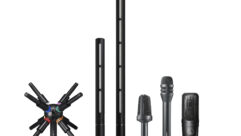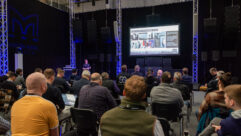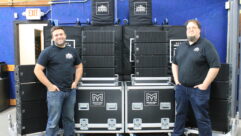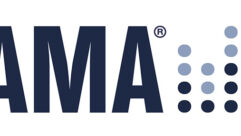Welcome to the Fun House: Audio in Themed Environments
Dec 1, 2001 12:00 PM,
Gordon Moore
Designing integrated systems for themed venues poses significant challenges to a systems design team. Unique combinations of mobile systems, stationary venues and security — plus special considerations like ambient noise levels from crowds — make for complicated jobs. Since these venues are often dense with people, machinery and activity, proximity is an issue, and planning is critical.
Weatherproofing
Some themed retail happens both inside and outside. Weatherproof and waterproof components are most critical in areas with large crowds and heavy use.
Radio Frequency Considerations
Wireless mics and two-way radios are useful in many situations, but can cause problems in larger venues like theme parks or expansive themed retail areas like the Virgin Megastore or the Forum Shops at Caesar’s Palace Las Vegas. Soundtronics Wireless, a wireless mic retailer and renter in Las Vegas, Nevada, and Burbank, California, has established a protocol for dealing with such complications. Soundtronics’ Dave Bellamy says the first step is to establish a performance standard, a basic operation strategy and a frequency coordination plan. Large venues will have several departments that will all need to work together, following frequency allocations.
Wireless mics share spectrum with both NTSC and DTV broadcasts. When planning RF use, Soundtronics accounts for both present and anticipated television broadcasts and makes sure wireless systems stay off those channels.
RF Allocation Plan
Blocks of useable frequencies are assigned to each department or sub-area. RF room must be kept open for concerts and acts that may come on a seasonal basis. Because many venues attract news and film crews, there must be spectrum available for electronic news-gathering and film production, too.
Safety
Bellamy reminds us to consider “life and limb issues” when using wireless systems. Low-powered RF systems can fail due to something as simple as a low battery and should not be relied upon for critical situations. Wireless communications should not be used where communications are crucial, as in event cueing.
Power and Placement
Venues always want longer-range RF. But this does not necessarily mean more transmitter power. The solution requires creative antenna design and placement. Log-periodic antennas and circular dipoles can be highly directional and offer gain improvements of around 12 dB on the receiver antenna side, improving range without raising transmitter power. Soundtronics integrates low-loss cables, tight band-pass filters and in-line RF amps. Bellamy applies 6MHz band-pass filters that are 3 dB down at 400 kHz outside the band and better than 30 dB down at 10 MHz away. He points out, however, that where the antenna is placed is as important as what the antenna is.
Maintenance
Any venue can be made functional for one day with careful babysitting, but themed environments get heavy, continual use and need steady maintenance day in and day out. Programmed maintenance must account for equipment mortality, RF connections, battery replacement and interconnection checks.










